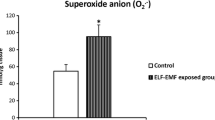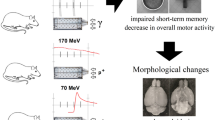The effects of short-term (2 h per day for 7 days) exposures to different doses of 2.1 GHz radiofrequency electromagnetic radiation (RF-EMR) on cognition and behavior of rats were examined. The animals were divided into three equal groups, sham-exposed group 1 and two RF groups irradiated with different doses, groups 2 and 3, respectively. To assess locomotor activity, recognition memory, and anxiety-related behavior, the open field (OF), novel object recognition (NOR), and marble burying (MB) tests were used, respectively. Overall results showed that both 45 and 65 V/m doses of 2.1 GHz RF-EMR did not lead to significant modifications of locomotor activity in the OF test. At the same time, higher doses (65 V/m) significantly (about two times) decreased the exploration time and number of touches for a novel object in the NOR test. In the MB test, both RF-EMR doses led to significant dose-dependent decreases in the number of buried marbles, which was indicative of lower levels of anxiety. Further studies are needed, regarding this particular type and level of radiation, for the development of methods to provide protection of the brain from harmful effects of RF-EMR exposure.
Similar content being viewed by others
References
K. K. Kesari, R. Meena, J. Nirala, et al., “Effect of 3G cell phone exposure with computer controlled 2-D stepper motor on non-thermal activation of the hsp27/p38MAPK stress pathway in rat brain,” Cell Biochem. Biophys., 68, No. 2, 347–358 (2014).
M. H. Esmaili, H. Masoumi, M. Jadidi, et al., “The effects of acute mobile phone radiation on the anxiety level of male rats,” Middle East J. Rehabil. Health Stud., 4, No. 2, e43478 (2017). doi: https://doi.org/10.5812/mejrh.43478.
J. C. Cassel, B. Cosquer, R. Galani, and N. Kuster, “Whole-body exposure to 2.45 GHz electromagnetic fields does not alter radial-maze performance in rats,” Behav. Brain Res., 155, No. 1, 37–43 (2004).
T. Liu, S. Wang, L. He, and K. Ye, “Chronic exposure to low-intensity magnetic field improves acquisition and maintenance of memory,” NeuroReport, 19, No. 5, 549–552 (2008).
S. N. Narayanan, R. S. Kumar, B. K. Potu, et al., “Spatial memory performance of Wistar rats exposed to mobile phone,” Clinics, 64, No. 3, 231–234 (2009).
S. N. Narayanan, R. S. Kumar, B. K. Potu, et al., “Effect of radio-frequency electromagnetic radiations (RF-EMR) on passive avoidance behavior and hippocampal morphology in Wistar rats,” Ups. J. Med. Sci., 115, No. 2, 91–96 (2010).
D. Hao, L. Yang, S. Chen, et al., “Effects of long-term electromagnetic field exposure on spatial learning and memory in rats,” Neurol. Sci., 34, No. 2, 157–164 (2013).
S. G. Cigdem and E. Hakan, “Effects of different duration time of exposure to 2100 MHz electromagnetic radiation on behavior and hippocampal levels of protein kinases on rats,” J. Neurol. Sci., 34, Nos. 4-60, 322–331 (2017). doi: https://doi.org/10.24165/jns.10160.17.
D. LeBlanc, D. Hatcher, and R. Post, “Finite-difference time-domain front-end utility,” in: Brooks Airforce Base, Texas, USA (2000).
A. O. Obajuluwa, A. J. Akinyemi, O. B. Afolabi, et al., “Exposure to radio-frequency electromagnetic waves alters acetylcholinesterase gene expression, exploratory and motor coordination linked behavior in male rats,” Toxicol. Rep., 4, 530–534 (2017). doi: https://doi.org/10.1016/j.toxrep.2017.09.007.
L. C. de Caires Jr., E. da Silveria Goulart Guimarães, C. M. Musso, et al., “Behavior and memory evaluation of Wistar rats exposed to 1.8 GHz radiofrequency electromagnetic radiation,” Neurol. Res., 36, No. 9, 800–803 (2014). doi: https://doi.org/10.1179/1743132813Y.0000000276.
M. P. Ntzouni, A. Stamatakis, F. Stylianopoulou, and L. H. Margaritis, “Short-term memory in mice is affected by mobile phone radiation,” Pathophysiology, 18, No. 3, 193–199 (2011). doi: https://doi.org/10.1016/j.pathophys.2010.11.001.
T. S. Aldad, G. Gan, X. Gao, and H. S. Taylor, “Fetal radiofrequency radiation exposure from 800-1900 MHzrated cellular telephones affects neurodevelopment and behavior in mice,” Sci. Rep., 2, 312 (2012). doi: https://doi.org/10.1038/srep00312.
O. Burman, G. Marsella, A. Di Clemente, and L. Cervo, “The effect of exposure to low frequency electromagnetic fields (EMF) as an integral part of the housing system on anxiety-related behavior, cognition and welfare in two strains of laboratory mouse,” PLoS One, 13, No. 5, e0197054 (2018). doi: https://doi.org/10.1371/journal.pone.0197054.
K. Wang, J. M. Lu, Z. H. Xing, et al., “Effect of 1.8 GHz radiofrequency electromagnetic radiation on novel object associative recognition memory in mice,” Sci. Rep., 7, 44521 (2017). doi: https://doi.org/10.1038/srep44521.
A. Thomas, A. Burant, N. Bui, et al., “Marble burying reflects a repetitive and perseverative behavior more than novelty-induced anxiety,” Psychopharmacology (Berl.), 204, No. 2, 361–373 (2009). doi:https://doi.org/10.1007/s00213-009-1466-y.
B. P. Salunke, S. N. Umathe, and J. G. Chavan, “Behavioral in-effectiveness of high frequency electromagnetic field in mice,” Physiol. Behav., 140, 32–37 (2015). doi:https://doi.org/10.1016/j.physbeh.2014.12.019.
Author information
Authors and Affiliations
Corresponding author
Rights and permissions
About this article
Cite this article
Gökçek-Saraç, Ç. Effects of 2.1 GHz Electromagnetic Radiation on Locomotor Activity, Recognition Memory, and Anxiety-Related Behavior in Rats. Neurophysiology 52, 261–266 (2020). https://doi.org/10.1007/s11062-021-09881-w
Received:
Published:
Issue Date:
DOI: https://doi.org/10.1007/s11062-021-09881-w




